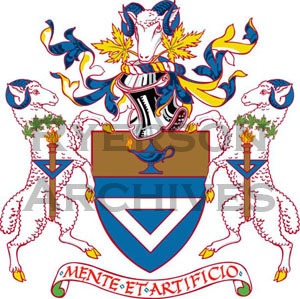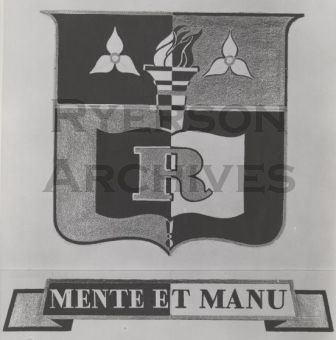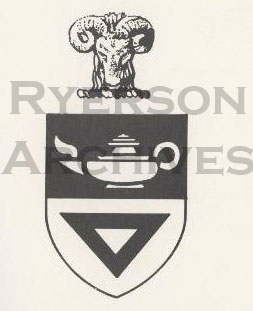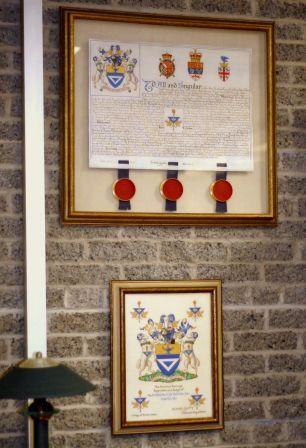They date back to the 12th Century and European knights. Knights painted them on their shields as a form of identification in battle. They have always been a symbol of honour, pride and bravery. Many governments have one as do many academic institutions. Toronto Metropolitan University has one – an official Coat of Arms
Official coats of arms are made up of required components. Each component is a depiction of a particular group of people. The components typically are a central shield (or a military ‘coat’), two supporters on either side, a helmet or hat above with billowing fabric or ribbons, a twisted roll of fabric called a torse or wreath, topped off with a crest of any number of representations, for example an animal’s front half, top half of a human, a bird, or bird’s wings, etc.
The Back Story of Ryerson’s Coat of Arms
In the first year (1948) of Ryerson Institute of Technology, Howard H. Kerr, the school’s first and only principal, saw the school’s potential as a so-called “MIT of the North” and visited Massachusetts Institute of Technology. For Kerr, a coat of arms would be the symbol that would establish the school as a legitimate institution.
So inspired by MIT, Kerr borrowed their motto Mente et Manu (With Mind and Hand). However, officially belonging to MIT, the motto was changed by 1950 to a similar version, Mente et Artificio (With Mind and Skill). Both were used on crests, such as the one below:
Ryerson’s First Crest
Ryerson’s second crest
Proceeding to apply for an official coat of arms in the 1960s, Kerr found himself persuading the College of Arms in London, England that Ryerson was worthy of its own unique design. It was granted in 1966.
And so, with Ryerson having its own official identity and coat of arms, coupled with the reputation of a sound fully-rounded technical education, recognition grew. The number of Ryerson applicants for the fall of 2012, as reported soon after the January 11, 2012 deadline, was for the first time the highest in the province at 40,553.
What follows is an explanation of Ryerson’s coat of arms and what Ryerson stands for and the coat of arms below of reference.
Torches:
(Appears on both rams)
The symbol of light, education, liberty, and increasing knowledge.
Lamp of Learning:
(Appears on the shield)
The symbol of intelligence and giving forth the flame of the spirit within. It is the light in the darkness, a symbol for inspiration.
Set Square:
(Used for technical drawings; appears on shield)
The symbol of artifact, construction, building, the practical and material.
Leaves:
Maple leaves, representing Ryerson’s Canadian heritage.
Rams:
(Two are supporters and one is the crest)
The ram, or aries, is a constellation representing our creative impulse through which potential becomes actual. In astrology, the aries governs the head and the brain.
Motto:
Mente et Artificio
While the coat of arms is reserved for use by the Chancellor’s Office and President’s Office, it is found in a number of places. The symbol is used for various official scholarly documents, but cannot be used for general information pieces such as flyers and brochures. If one would like to use a replication of the coat of arms, special permission must be requested.
You may also have seen the coat of arms or the crest on items such as university jackets, pins, and plastic book bags. Samples of some of these can be found at the Ryerson Archives; here are two clothing crest:
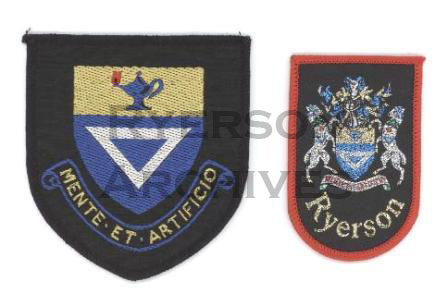
As there has only ever been one official coat of arms for Ryerson, other emblems of note were used before its creation. Below are some examples of related symbols of the past used to represent Ryerson:

This symbol contains the main heraldic symbols of the coat of arms. In this case, there is only one ram. (from the Academic Calendar covers 1965-66)
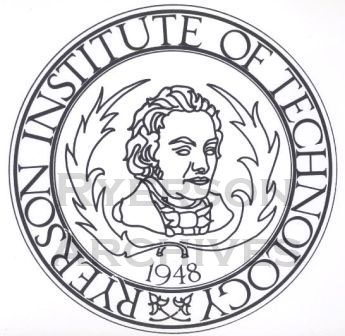
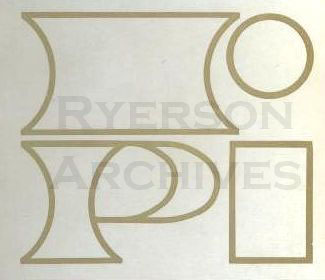
To see samples of the Ryerson coat of arms and related symbols and documents, or for more information, please visit the Toronto Metropolitan University Archives located on the third floor of the library, open Monday to Friday from 9:00 a.m. to 5:00 p.m.
